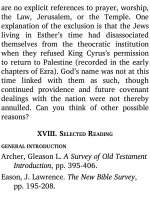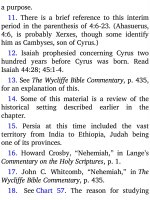Jensens survey of the old testament adam 73
Bạn đang xem bản rút gọn của tài liệu. Xem và tải ngay bản đầy đủ của tài liệu tại đây (79.98 KB, 4 trang )
reason for a second count, read the pivotal
chapters cited on the chart. (A pivot is a
turning point in a book’s structure. In the
case of a historical account, the change that
follows a pivot may be for the better or for
the worse.)
3. According to the chart, how many
major divisions comprise the book of
Numbers? Study the various outlines
showing this. Refer to your Bible text to
support these outlines. For example, read
10:11-13
and
22:1,
observing
the
geographical movements.
4. According to the chart, how much time
is covered by each of the three divisions? (It
should be noted here that, while the middle
section covers a span of about thirty-nine
years, there is scarcely any record of the
events of these many years of wanderings.
Most of the section deals with events
immediately before and after the actual
wanderings. This is a good example of the
Holy Spirit’s selectivity as to what He
inspired the biblical authors to include and
exclude.)
5. Read through Numbers again, referring
to your chapter titles and the extended
eight-point outline shown on the chart. This
will give you a good overview of the book.
IV. PROMINENT SUBJECTS
(chaps. 1 and 26)
Both censuses of this book were counts of
the ghting forces of Israel, not of the total
population. On the basis of those censuses,
the total population has been estimated to
be around two million.1 The people
occupied a very large area as they traveled,
and were miraculously fed and sustained
along the way.
A. THE CENSUSES
B. FINAL INSTRUCTIONS BEFORE THE JOURNEY
(5:1—
10:10)
The rst four chapters of Numbers record
the directions which Jehovah gave Moses
regarding preparations for the journey as
related especially to the community of the
camp as a whole. In chapter 1 the
instruction was, “Count the warriors of the
camp”; in chapter 2, “Arrange the tribes in
the camp”; and in chapters 3 and 4, “Take
care of the tabernacle of the camp.”
Beginning at chapter 5, the directions are
aimed at individuals within the camp. Read
these chapters with the following outline in
mind:
1. Put out the unclean (5:1-4).
2. Judge the guilty (5:5-31).
3. Separate yourselves (Nazirite vow)
(6:1-27).
4.
5.
6.
7.
Offer gifts (7:1-88).
Cleanse the Levites (7:89—8:26).
Keep the Passover (9:1-14).
Follow your leaders (9:15—10:10).
C. THE SPIES’ REPORTS AND THE PEOPLE’S UNBELIEF
(12:16—13:33)
Read the passage. As the Israelites
approached the land of Canaan from the
south (Map F), Moses sent spies ahead to see
what the Israelite armies would be facing.
God chose to use this situation as a terminal
test of faith. He knew what the report would
be—overwhelmingly fearful from a human
standpoint. What God wanted to do was to
face the people with the ultimate in the test
of their faith: Would they move on in faith
into the jaws of apparent annihilation?
Caleb’s recommendation was to go in and
possess the land, impregnable as it seemed.









